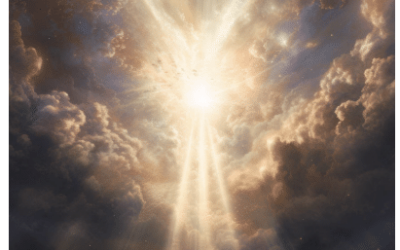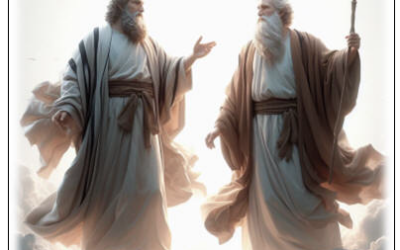Revelation 22:4 says that people will “see the face of God.” But doesn’t God say in Exodus 33:20 that “You cannot see My face, for no man can see Me and live!” Is this a contradiction?
Important contextual interpretations
Revelation 22:4 is a very special verse. It is the culmination of the revelation of God. Scholars deem it “The Beatific Vision.” To “see the face of God” will be an incredible moment and experience, and it is not unreasonable to suggest that this is more than what man has experienced in the past.
It is first important to understand the context of Revelation 22:4. This experience will take place in the New Heaven and New Earth. This means that the verse is for believers and that the believers will be in their resurrected bodies. Paul calls this “the change” (1 Corinthians 15:50-58). A simple biblical survey of God’s revelation to man reveals that man in his former state cannot look upon the face of God and live, nevertheless experience Him in His fullness.
Consider this brief overview:
- God’s Revelation in Eden (Genesis 2:16-17, 3:8-24)
- God’s Revelation in Heaven (Isaiah 6)
- God’s Revelation on the Mountain (Exodus 33:18-23)
- God’s Revelation in the Tabernacle/Temple (2 Samuel 6:7; 2 Chronicles 26:16-23; Leviticus 10:1-3)
- God’s Revelation Moving (Ezekiel 11:23)
- God’s Glory in Jesus (John 1:14)
- God’s Glory in Spirit (John 16:7)
- God’s Glory in Man (1 Corinthians 3:17)
- God’s Glory in Eternity (Revelation 21:3)
Although far more verses can be used to detail the history of God’s revelation to man, these verses capture the essence of how man’s relationship with God has been injured and limited. God went as far as to tell Moses in Exodus 33 that “no man can see My face and live.” Even the Seraphim in Isaiah 6 “covered their faces.” This sheds important light on Revelation 22:4. When man is finally able to “see the face of God,” it will indeed be an incredible moment. This is because man will finally experience the fullness of God. That is, we will finally be able to look upon God the Father and live. John 16:7 arguably reveals that man can only experience so much of God’s revelation at a time, but in Revelation 22:4 we will see and experience Him in full.
A distinction needs to be made here concerning the face of God the Father and the face of God the Son. Some have suggested that Revelation 22:4 is not talking about the face of God the Father but instead the face of Jesus Christ. While both God the Father and God the Son are one and the same God, Revelation 22:4 is speaking about the face of the Father. The following observations give biblical reasons as to why:
-
We saw Jesus’ face during His first coming and will see it in His second coming (not including after His resurrection). There would be no significance or reason for John to write about seeing the face of God if we have already seen it. This is not to degrade the value of seeing Jesus’ face, only that seeing Jesus’ face is the way to seeing the Father’s face (John 14:6).
-
This is the same language used in Exodus 33:18-23 and John 1:18, which both concern God the Father. Revelation 22:4 is the “bookend” to this “story.” Moreover, John wrote John 1:18 after Jesus’ first advent. Although the chronology of the verse is before Jesus made claim to be the Father, John wrote the book after His claim, giving reason to suggest that there is indeed a distinction between seeing the face of Jesus and the face of God the Father. Man has yet to see the Father’s face.
-
Revelation 22:1 details the throne of “God and the Lamb,” meaning God the Father and God the Son. John uses the word “God” for the face we will see in 22:4, not “Lamb.” Moreover, the book of Revelation makes a clear distinction between God the Father and God the Son (although they are one and the same, they are different Persons in the Godhead). The author uses “God” here, not “the Lamb.”
-
1 Corinthians 15:24 is a prophetic verse speaking about the events unfolding in Revelation 22. Regardless of the millennial perspective, the New Heaven and New Earth follow the millennial reign of Christ and then Jesus hands over the “kingdom keys.”
-
Jesus said in Matthew 5:8 that the “pure in heart will see God.” That is, God the Son made a contextual distinction between seeing Him and seeing the Father.
-
Throughout the Bible, man has attempted to see God in all of His splendor, but it has been impossible (Genesis 11:1-9; 2 Samuel 6:7; 2 Chronicles 26:16-23; Leviticus 10:1-3). In Revelation 22:4 that will all change!
Some observations and questions answered
-
But if God is Spirit (John 2:24), how can He have a face? There are many times in the Bible where God is said to have “human” features. Isaiah 59:1 mentions His hand and His ear. Zechariah 2:8 says that He has an eye. Matthew 4:4 mentions His mouth. In Genesis 3 He “walked” in the Garden. While these are all, however, arguably anthropomorphisms (a word meaning “human form” or a symbolic representation used to make God’s actions more understandable to man), the idea is still present that man will be able to see God in a way that we never have. In this thought, the “face” could arguably be an anthropomorphism, but this is still a sight that man has not been capable of seeing in the past.
-
But Jesus said in John 14:9, “If you have seen me you have seen the Father.” This verse speaks to the various roles that each Person of the Godhead performs. Jesus was the physical representation of God the Father, and although when we see Him, we see God, we do not see the full and total manifestation of the Father. That is, we do not see the Father in His full glory (otherwise we would die). This is captured in John 1:18 when John says that “no one has seen God at any time.” Jesus, although God, was “limited” or “subjected” by the flesh. The full context of John 14 says that Jesus “explains” the Father. This is much of what His earthly ministry was about.
-
But the book of Revelation is the “revelation of Jesus,” so Revelation 22:4 must be about Him specifically. Yes, Revelation is indeed the book of the unveiling of Jesus Christ, but because Jesus is God, you cannot talk about Him without also including the other two Persons in the Godhead. They too are unveiled in deep ways throughout the book, especially in the last two chapters when John talks about the Eternal Heaven and Earth. The thrust of these chapters is that earth finally can be a place for God to dwell in His fullness. He is arguably still in the current “intermediate” state of Heaven during the Millennium (since it has yet to be destroyed), which is why it is so significant that He comes down to dwell with man on earth during eternity.
-
But doesn’t this mean that there will be three Gods? Absolutely not! God is Triune. Scripture is evident about this. Even in Genesis 1:26, God speaks as “Us” in creating mankind. Although Triune, He is completely One in unity. That is, God the Father, God the Son, and God the Spirit are all equal. We fail to comprehend this completely because of our corrupted minds. We cannot understand perfect unity, or how three can be one, but God is perfectly unified (Ephesians 4:5; James 2:19).






